British Ordnance Collectors Network
You are using an out of date browser. It may not display this or other websites correctly.
You should upgrade or use an alternative browser.
You should upgrade or use an alternative browser.
3.7 inch projectile
- Thread starter ted99
- Start date
Chris 42 RQ
Well-Known Member
Interesting item
That is interesting as it was not what I was expecting you to show!
I wonder if this could be a projectile for the 3.7 lightweight mountain gun as was used in jungle area's where transportation was a big problem and the weapon was taken apart for transit as this used "compact" thus lightweight ammunition.
Also a bit unusual are the indents/cutouts in the nose portion?
That is interesting as it was not what I was expecting you to show!
I wonder if this could be a projectile for the 3.7 lightweight mountain gun as was used in jungle area's where transportation was a big problem and the weapon was taken apart for transit as this used "compact" thus lightweight ammunition.
Also a bit unusual are the indents/cutouts in the nose portion?
Thank it Chris, I am new to this game. I have tried to find out what it could be. My first thought was anti-air craft but looking at pictures it didnt look right.
The date I assumed was 1925 from the 6.25 on the base?? as I said I am still learning, Paid 15 for it. it came with a fuze plug if thats the right description marked with II A.H LS No1.
Thanks for any help anyone can give me.
Ted
The date I assumed was 1925 from the 6.25 on the base?? as I said I am still learning, Paid 15 for it. it came with a fuze plug if thats the right description marked with II A.H LS No1.
Thanks for any help anyone can give me.
Ted
Quatermass
Well-Known Member
Stampings.
On the base of the shell :-
(a) Calibre and numeral.
(b) Manufacturers' initials or recognised trade name and date of completion.
(c) Letters "SMK" on smoke shell.
(d) Numeral in ring, denoting size of charging hole in smoke shell.
Source: Handbook for the Q.F. 3.7-in. Mark I Howitzer. 1926
On the base of the shell :-
(a) Calibre and numeral.
(b) Manufacturers' initials or recognised trade name and date of completion.
(c) Letters "SMK" on smoke shell.
(d) Numeral in ring, denoting size of charging hole in smoke shell.
Source: Handbook for the Q.F. 3.7-in. Mark I Howitzer. 1926
Quatermass
Well-Known Member
Chris 42 RQ
Well-Known Member
Still a mystery?
Hi Ted any chance of a picture of the threads in the top along with some sort of scale and also perhaps a vertical shot to show off the cutouts in the upper rim.
An absolute bargain at 15-00 and almost a giveaway if you ask me.
Hi Ted any chance of a picture of the threads in the top along with some sort of scale and also perhaps a vertical shot to show off the cutouts in the upper rim.
An absolute bargain at 15-00 and almost a giveaway if you ask me.
Quatermass
Well-Known Member
Hi Chris, the indents/cutouts in the nose aren't that unusual, there used for securing the fuze to the shell by punch stabbing.
Chris 42 RQ
Well-Known Member
Cheers Quatermass
Thanks for the info Quatermass !
Would I be right in saying that that was a method more common to the first world war ?Hi Chris, the indents/cutouts in the nose aren't that unusual, there used for securing the fuze to the shell by punch stabbing.
Thanks for the info Quatermass !
Quatermass
Well-Known Member
Would I be right in saying that that was a method more common to the first world war ?
Thanks for the info Quatermass !
The indents were far from universal even with WW1 shells, later projectiles all tended to use a steel set screw to attach the fuze via a hole in the shell shoulder.
Ted, you have a HE shell. Are there any Roman numerals after the 3.7" on the base? a picture would be good.
Quatermass
Well-Known Member
The Mark III high explosive shell is forged steel with a 4-calibre radius head and a length of 2.66-calibres. Near the base is an under-cut grove with waved ribs or serrations, into which is pressed a copper driving band shaped externally to R.L. design 29759; the front part of the band is serrated to enable the projectile to grip the bore when loaded. A hardened steel plate is screwed or riveted into the base of the shell. The upper part of the cavity is screwed to the 2-inch fuze hole gauge, or as an alternative fitted with a steel bush, threaded to a similar dimension, to receive the 101E, 106 or 106E fuzes, below which a ledge is formed to make the shell suitable for use with an exploder container.
For air-burst ranging, fuze 188M, with No. 12 adapter and No. 2 gaine, is used.
Source: Handbook for the Q.F. 3.7-in. Mark I Howitzer. 1926
For air-burst ranging, fuze 188M, with No. 12 adapter and No. 2 gaine, is used.
Source: Handbook for the Q.F. 3.7-in. Mark I Howitzer. 1926






